Half of sewage treatment works 'cannot handle' demand

Thames Water has 351 sewage treatment works
- Published
More than half of Thames Water's sewage treatment works are unable to deal with the volume of sewage they receive, campaigners have claimed.
Research conducted by the Oxford Rivers Improvement Campaign (ORIC) identified 181 treatment works that could not handle the amount of sewage arriving.
It said in some cases, such as Hanwell and Bourton-on-the-Water, facilities were treating less than half of the sewage received.
Thames Water said it was putting in a "record amount of investment" to address "ageing infrastructure" and meet the demands of population growth and climate change.
ORIC said 94 treatment works had between 80% to 100% of the necessary treatment capacity, 70 were between 60% and 80%, and an "alarming" 17 sites functioned at less than 60%.
"A lack of treatment capacity leads to untreated sewage discharges/storm overflows happening more frequently," it added.
"Most of the worst-performing works are found outside of London in headwater streams and tributaries of the River Thames, where raw or partially treated sewage is likely to be more harmful to the river ecosystem, as small waterbodies cannot dilute pollutants effectively."
The findings can be viewed on the Oxford Rivers Project Portal's interactive map, external.
John Bryden, head of improving rivers at environmental charity Thames21, and regional development manager at The Rivers Trust, said: "Thames Water's underperforming sewage works need to be upgraded to meet modern regulatory requirements.
"Where housing growth is planned, upgrades to sewage works are needed before the development is constructed."
ORIC co-founder Mark Hull said there was a "rising tide of raw sewage discharges" into the Thames, describing it as "astonishing" how some treatment works were operating without sufficient capacity.
Thames Water, which has 351 sewage treatment works, was hit with a record £122.7m fine by regulator Ofwat for repeatedly breaching rules over sewage spills and making payouts to shareholders when in dire financial straights.
Tessa Fayers, the company's waste and bioresources director, said: "We believe that all storm discharges to the environment, even when permitted, are unacceptable, however, it's important to remember that the system was historically designed in this way to prevent sewage backing up into homes.
"This is an issue that will take many years and significant investment to resolve and is at the heart of our storm overflow action plan.
"Transparency is at the heart of what we do, and we were the first water company to publish a real time data map on our website, external showing all storm overflows, before it became legal requirement to do so."
Get in touch
Do you have a story BBC Oxfordshire should cover?
You can follow BBC Oxfordshire on Facebook, external, X (Twitter), external, or Instagram, external.
Related topics
- Published20 June

- Published12 February

- Published13 May

- Published16 May
